Vintage 1970s Photos Show Lost Sites of NYC's Lower East Side
A quest to find his grandmother's birthplace led Richard Marc Sakols on a mission to capture his changing neighborhood on film.


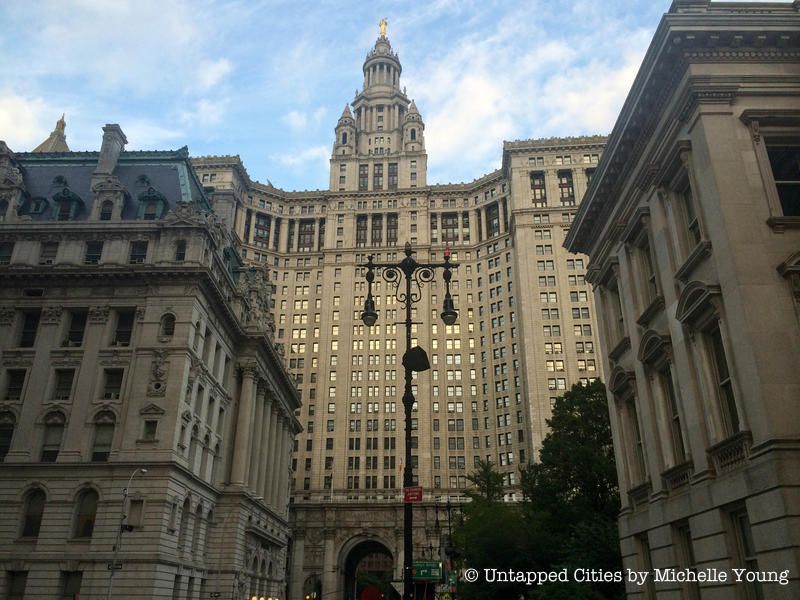
The Manhattan Municipal Building, located at 1 Centre Street in Lower Manhattan, is one of New York City’s most interesting buildings. From its intricate architecture to its rich history (not to mention the many hidden gems found inside), the structure is among the largest government office buildings in the world, home to over 2,000 employees from a dozen municipal agencies.
The Manhattan Municipal Building, which looms tall, forms an inspiring counterpoint amongst the various government buildings nearby, including City Hall, the Tweed Courthouse, the Surrogate’s Courthouse, and others.
The following are 12 of its best kept secrets spanning both the past and present:

The Municipal Building cupola is one of the most coveted off-limits spots at Open House New York Weekend each year, located on the building’s 36th floor and offers breathtaking 360 degree views of Lower Manhattan and the Midtown skyline.
You take a special elevator to the top from the Manhattan Borough President’s office. The cupola surrounds you in a beautiful ring of Corinthian columns and provides an unobstructed vantage point. Check out our photographs from a previous visit.
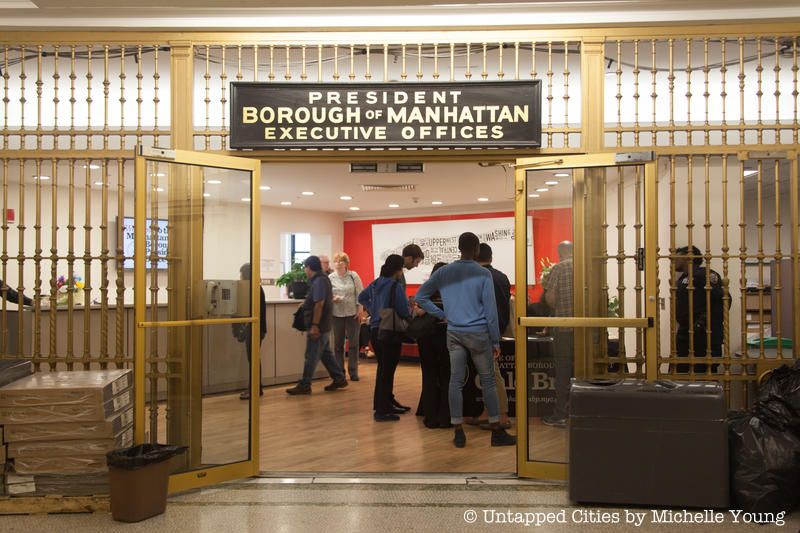
Not many offices can boast such an intricate and unique entrance. The gilded entranceway and vintage signage of the Manhattan Borough President’s office on the 19th floor harkens back to an earlier era, even though the furnishings inside are distinctly modern. The gold color of the entranceway matches the elevator banks on this floor as well.
On the back wall of the office lobby is a map showing the neighborhoods of Manhattan in a fun, graphic way. Further on in this list of secrets is something fun about the bathrooms that that the staff will eagerly share with visitors!
The Manhattan Municipal Building’s office of Manhattan Borough President is also home to a a little known art gallery with rotating exhibits, called the Maggi Peyton Gallery, in honor of a woman the office describes as “a politico, feminist, and longtime aide (and curator of the gallery) to Manhattan Borough Presidents.”
An exhibit in March for Women’s History Month, featured a wide array of pins, photographs, posters, clothing, and political memorabilia dedicated to women’s political history. The recent exhibition in October, “Better with Age,” featured works from artists over 60 years of age, selected by a jury.

If you visit the Manhattan Municipal Building’s cupola, you’ll discover that it takes three separate elevator rides to reach the top. The first ride will stop at the 19th floor, where the office of Manhattan Borough President Gale Brewer is located. From there, you have to take a freight elevator to the 24th floor and then transfer to a small golden elevator, specifically meant to take visitors through the Manhattan Municipal Building’s tower (and ultimately up to the cupola).


One of the first things the staff of the Borough President’s office told us when we visited was that the “best views are from the bathroom.” While the cupola of the Manhattan Municipal Building will give you great, elevated views of the Woolworth Building, and other surrounding buildings, the bathroom of the Borough President’s office gives a clear bird’s eye view of the Brooklyn Bridge. It’s almost twenty floors lower than the cupola, so you can see the busy traffic patterns on the Brooklyn Bridge on and off ramps and get a great view of Dumbo as well.
Next time you visit, if you see people with cameras in the bathroom, now you know why.
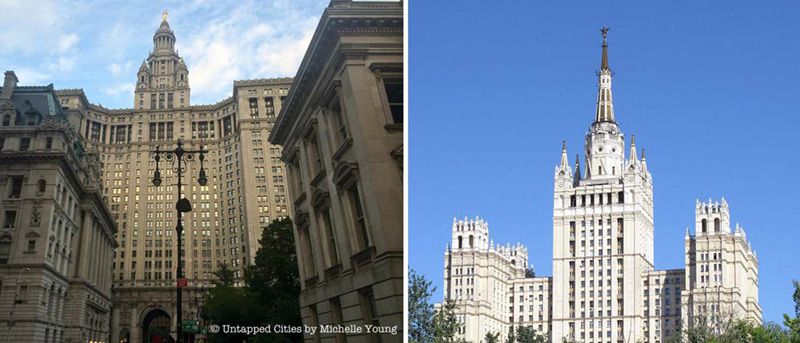
Left, Municipal Building in Lower Manhattan. Right, The Kudrinskaya Square Building. Image via Wikimedia: Lodo27
The 40-story Manhattan Municipal Building is quite the architectural feat. William M. Kendall of the noted architectural firm, McKim, Mead & White, designed the structure, which has influenced various buildings across other American cities, including the Terminal Tower in Cleveland (which has its own observation deck) and the Wrigley Building in Chicago.
But most surprisingly, the Manhattan Municipal Building was also the basis for Moscow’s Seven Sisters, one of the city’s seven cathedral-like skyscrapers made in the Stalinist style. You can see their striking resemblance in the pictures above. Also, check out other sister buildings around the world here.

One of the major features of the Manhattan Municipal Building is its open plaza that is framed by Corinthian columns. This plaza flows into a central triumphal arch, which was actually inspired by the Arch of Constantine in Rome, Italy.
In addition, the building’s terra-cotta vault takes after the Palazzo Farnese and its columned entrance was possibly modeled on Bernini’s Colonnade at St. Peter’s. Like the rest of its facade, the arch was so grand that automobile traffic once flowed through it before traffic patterns on Chambers Street were changed. Today, it’s open to pedestrians and foot traffic.
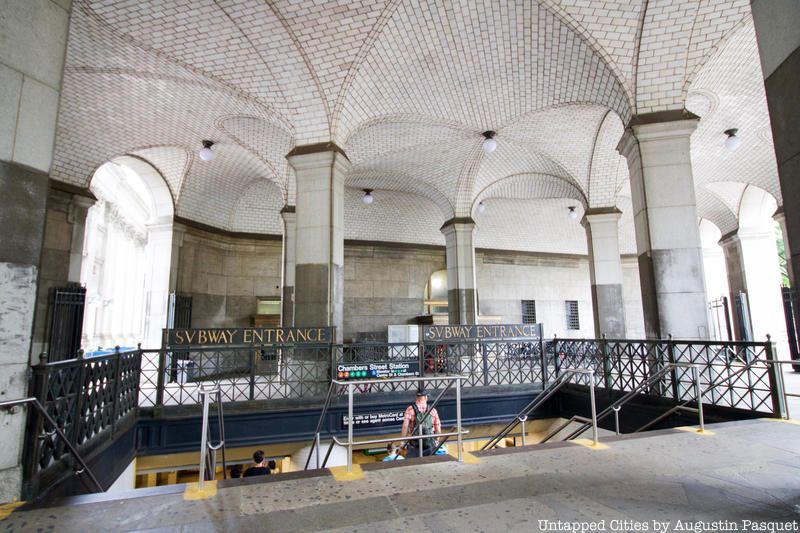
The Manhattan Municipal Building was once home to WNYC Radio, the first radio station in the country to break the news of the Japanese attack on Pearl Harbor on December 7, 1941 (and New York City’s continued main source for civil defense information during WWII and into the 1950s).
WNYC eventually occupied 51,400-square-feet of rent-free space scattered around eight floors of the Manhattan Municipal Building. In 2008, however, it moved to a new location at 160 Varick Street, where the station remains today.


When McKim, Mead and White entered the competition to design the Municipal Building, the firm had never designed a skyscraper. Several designs for new municipal buildings were proposed during this time, including a 1960s idea (see above) which would have led to the demolition of landmarked Surrogate’s Courthouse, Tweed Courthouse, Emigrant Savings Bank, and the New York Sun (A.T. Steward Department Store) buildings.
See more never built buildings in Lower Manhattan here.
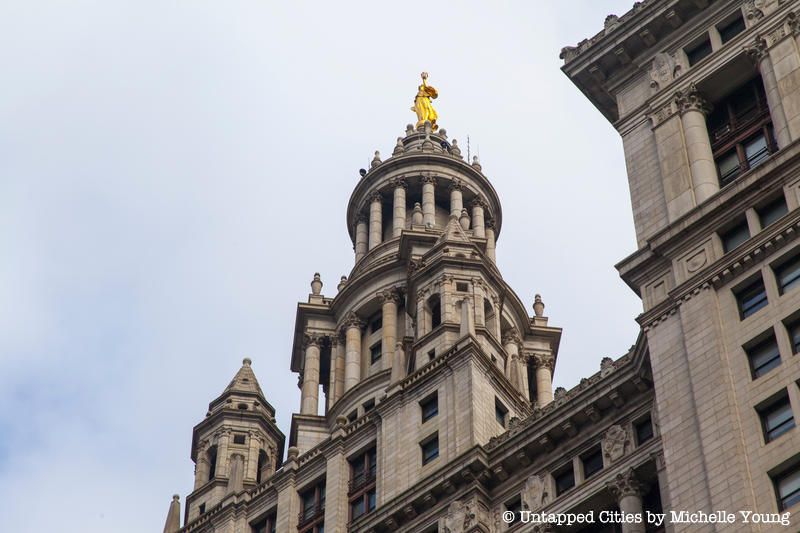
The image of Audrey Munson has been memorialized all over New York City, though few people know her name. Munson was a Gilded Age model, posing for illustrators, painters, and sculptors across the city, though she came to a tragic end. A golden, 25-foot tall rendering of Munson, called “Civic Fame,” stands atop the Municipal Building. The statue, the third tallest after the Statue of Liberty and the “Bellerophon Taming Pegasus” at Columbia Law School, holds a crown with five towers which represent the New York City boroughs.
Depictions of Munson can also be seen at the New York Public Library and the southwest entrance to Central Park. Unfortunately, Munson was committed to an institution for the insane at age 39 where she remained for 65 years until her death at age 104.

The Manhattan Municipal Building was the first to incorporate a subway station in its base. The vintage subway entrance is regarded as one of the most beautiful stations in the city; it features 11 columns and tiling done by Rafael Guastavino, the Spanish architect and building who tiled the famed City Hall station and Grand Central Terminal.
According to MCNY, he “devised a series of elegant vaults to cover the space, adapting to its various shapes three basic forms: the barrel vault, used along the length of the colonnades; lunettes, curving between the columns; and groin vaults, to accommodate the diversely shaped polygons spanning the internal columns.”
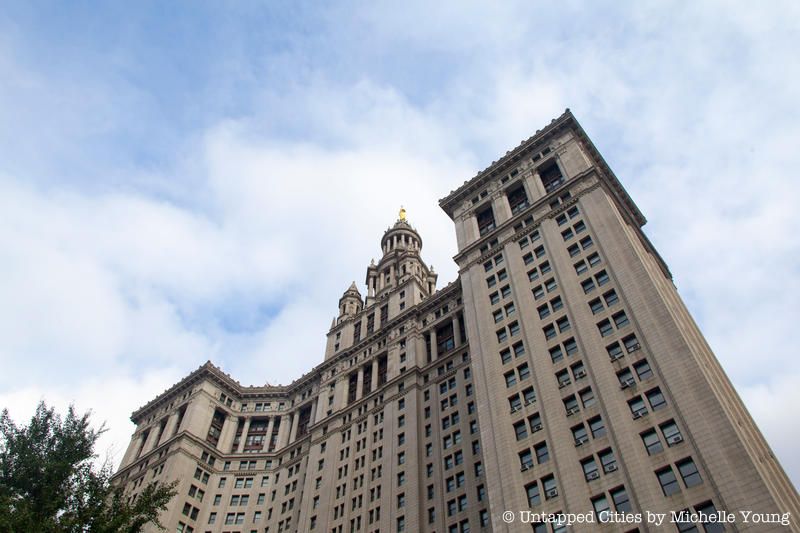
When the Manhattan Municipal Building, which cost $15 million to construct, was completed in 1914, it was New York City’s fourth tallest building. Standing at 25 stories and 580 feet, the Municipal Building was only surpassed in height at the time by The Woolworth Building, The Met Life Tower and The Singer Building.
Next, take an Inside Video Look of The Manhattan Municipal Building and read about the Most Visible New York Woman You Don’t Know.
Subscribe to our newsletter